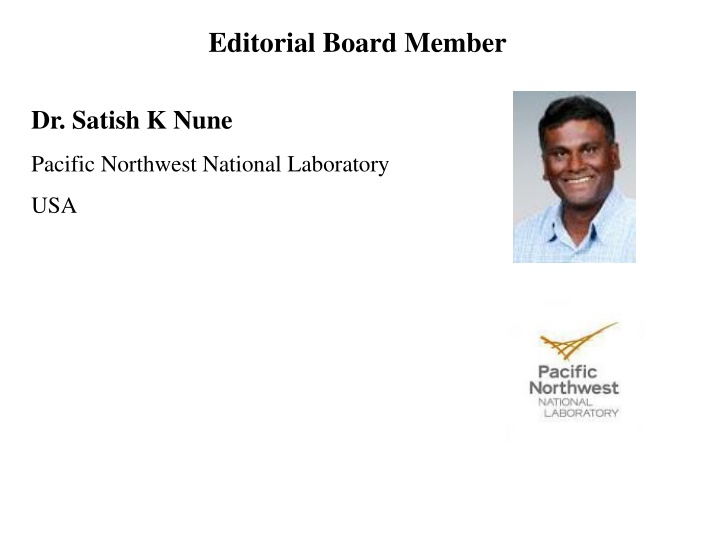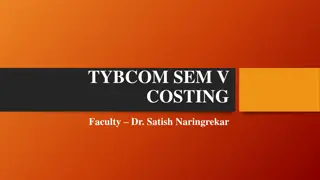
Dr. Satish K. Nune - Research Scientist and Nanomaterials Expert
Dr. Satish K. Nune, a research scientist at Pacific Northwest National Laboratory, specializes in nanomaterials and nanoparticle synthesis. His work focuses on developing safe nanomaterials for biomedical applications, especially in the field of nanomaterial drug delivery for more effective treatment strategies.
Download Presentation

Please find below an Image/Link to download the presentation.
The content on the website is provided AS IS for your information and personal use only. It may not be sold, licensed, or shared on other websites without obtaining consent from the author. If you encounter any issues during the download, it is possible that the publisher has removed the file from their server.
You are allowed to download the files provided on this website for personal or commercial use, subject to the condition that they are used lawfully. All files are the property of their respective owners.
The content on the website is provided AS IS for your information and personal use only. It may not be sold, licensed, or shared on other websites without obtaining consent from the author.
E N D
Presentation Transcript
Editorial Board Member Dr. Satish K Nune Pacific Northwest National Laboratory USA
Biography Dr. Nune is a Research Scientist at Pacific Northwest National Laboratory (PNNL), Richland, WA currently working on the development of new porous materials with very high surface area for sensing, Imaging, delivery, and capture applications. Dr. Nune also teach a course in Nanomaterials at Washington State University (WSU)-Tri- Cities, WA as an adjunct teaching faculty. > > >
He has extensive experience in shape selective synthesis and surface functionalization of various materials including polyelectrolyte complex nanoparticles, metal nanoparticles (Au and Pd), nanosized zeolitic imidazolate frameworks (ZIF), and Prussian blue analogues.He also serve as peer reviewer for ACS Nano, Nanoletters, Small, and Chemical Communications.
Research Interests Nanomaterials/Nanoparticle Synthesis and Fabrication/Nanochemistry safer Nanomaterials for Biomedical Applications
Nanomaterial Drug Delivery Nanomaterials are the future of drug delivery Drugs are able to reach their site of action more effectively
Bodily system barriers are able to be broken with nanocarriers Advanced materials can target various cells, such as cancer cells.
Drugs with different molecular shapes and chemical properties can be synthesized Different properties results in greater possibilities
Background Information All drugs face several transport barriers Plasma membrane The acidic environment of endolysosomes Nuclear membrane Multiple drug resistance mechanism from their site of introduction to their molecular site of action.
Advantages 1. Very small size High-resolution image of detonation nanodiamonds 2. High surface-to-volume ratio 3. One or more therapeutic drugs can be attached to
Advantages 4.Attach to specific target cells and organs with selected binding agents 5.Helps to avoid the fluctuations of drug (by using time-release)
Specific Cancer Drug Design: Carbon Nanotubes Antibodies are designed that will fight cancer cells Carbon Nanotube carriers have molecular strands that contain the antibodies and a link system to cancer cells Recognize cancer cells by pH, biological markers
Specific Cancer Drug Design: Carbon Nanotubes Carbon Nanotubes can be PEGed and attached with antibodies to bring it specifically to a cancer cell The drugs inside the nanotube can be released in the presence RF frequencies Metal nanotubes also heat in presence of RF waves, and burn up cancer cells
Specific Cancer Drug Design: Nanodiamonds Drug can be placed in nanodiamonds Nanodiamonds contain receptors that allow them only to bind and react with tumor cells Nanodiamonds release drug into tumor cell and result in highly effective treatment
Thank You..! Thank You..!





